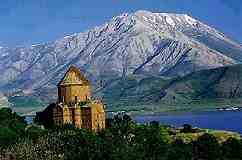After the fall of the Hittite empire, at the beginning of the first millennium BC, a new kingdom was formed in eastern Anatolia, which was to survive for three hundred years. This was the Kingdom of the Urartu, who were related to the Hurrians and were closely related to the Hittites in origin. However, the Urartu are historically looked upon as a civilization that had its own particular set of characteristics. The Urartu carried many of the customs and traditions of the Hittites into the first millennium, and can be said to have been a typically Anatolian culture. During the Early Urartu period, they were grouped in a series of emirates known as the Nairi, but in 900 BC, they formed a confederation under a central monarch.
 We know from inscriptions that the first Urartu ruler was Aramu (860-840 BC), followed by Sardur I (840-830 BC). Sardur I was responsible for adding a tower to the fortress of Van, which was completed during his reign. The inscription refers to him as the ruler of the Nairi, suggesting that the other emirates had rallied around him by this time. During the reigns of Sardur I and his successor Ishpuinis, (830-810 BC) the capital of Urartu was Van, which became steadily larger and more prosperous. Ishpuinis appointed his son Menuas as co-administrator during his reign and extended the Urartu frontiers, taking the city of Mushashir near Gevas. This made the Urartu a significant threat to the Assyrians. King Ishpuinis died in 810 BC and was succeeded by his son Menuas (810-780 BC). He was followed by Argishtish I (780-760 BC). The latter extended the Urartu frontiers even further and built up a chain of fortresses against potential foes. After the death of Argishtish I, Sardur II came to the throne (760-730 BC), and it was during his reign that the Urartu state reached its greatest proportions. Upon his death, he was succeeded by Rusas I (730-713 BC), during whose reign the Urartu were confronted with fierce opposition from the Assyrians. The frontiers of Urartu were threatened on several occasions, and to combat this, the Urartu built buffer towns on the edges of their territory that were abandoned in times of danger, and later inhabited.
We know from inscriptions that the first Urartu ruler was Aramu (860-840 BC), followed by Sardur I (840-830 BC). Sardur I was responsible for adding a tower to the fortress of Van, which was completed during his reign. The inscription refers to him as the ruler of the Nairi, suggesting that the other emirates had rallied around him by this time. During the reigns of Sardur I and his successor Ishpuinis, (830-810 BC) the capital of Urartu was Van, which became steadily larger and more prosperous. Ishpuinis appointed his son Menuas as co-administrator during his reign and extended the Urartu frontiers, taking the city of Mushashir near Gevas. This made the Urartu a significant threat to the Assyrians. King Ishpuinis died in 810 BC and was succeeded by his son Menuas (810-780 BC). He was followed by Argishtish I (780-760 BC). The latter extended the Urartu frontiers even further and built up a chain of fortresses against potential foes. After the death of Argishtish I, Sardur II came to the throne (760-730 BC), and it was during his reign that the Urartu state reached its greatest proportions. Upon his death, he was succeeded by Rusas I (730-713 BC), during whose reign the Urartu were confronted with fierce opposition from the Assyrians. The frontiers of Urartu were threatened on several occasions, and to combat this, the Urartu built buffer towns on the edges of their territory that were abandoned in times of danger, and later inhabited.
Rusas I was succeeded by his son Argishtish II (713-685 BC) after whom Rusas II (685-645 BC), Sardur III (645-625 BC), Erimena (625-605 BC), and Rusas III (605-590 BC) reigned in turn. He was followed by Sardur IV, who reigned between 590-585 BC. The Urartu were weakened by the constant raids of the Assyrians, Medes and Scythians. In the end, the state of Urartu was annihilated in 585 BC by the Scythian invasion. The Urartu, a tribe of powerful warriors in times of war, were farmers in times of peace. They were ruled by monarchs who also bore the title of chief-priest or envoy of Haldi, the major deity. Other deities in the Urartu pantheon included Teisiba, god of the heavens, who was known as Teshub among the Hittites and the Hurrians, and Siwini, the sun goddess. Many temples dedicated to Haldi, some of which were adjoining royal palaces, while others were free-standing structures, have been unearthed in excavations at Altintepe, Toprakkale, Patnos and Cavustepe. Urartu excavations have revealed not only palaces and temples of the Haldiye period, but also houses of the period, complete with windows and balconies. The interiors of these houses were decorated with various motifs. However far away the water source may have been, each settlement had a complete water supply and drainage system. One feature of Urartu architecture that was to be very influential in the Near East was the blind arch, and we can see that the layout of Urartu buildings was the precursor to that of the Iranian apadana layouts. Urartu fortresses, solid structures of dressed stone blocks were thought to have numbered thirty in all. The most important of these were the fortresses at Van, Anzaf, Cavustepe and Baskale. The art of metalwork was certainly highly advanced in Urartu, and perhaps the greatest proof of this was the fact that Urartu artifacts were exported to Phrygia and Etruria. This is how the magnificent bull-headed cauldrons of the Urartu came to be found in Italy.

